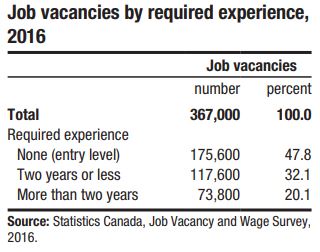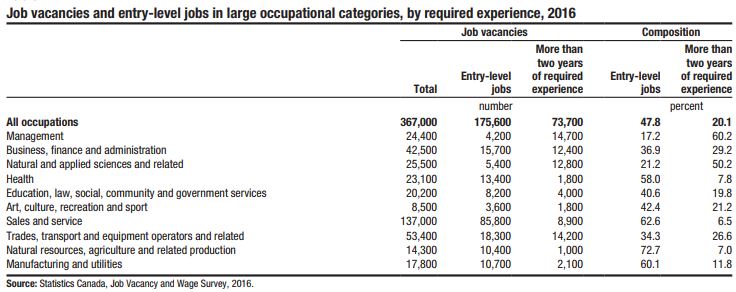For additional information relating to this article, please contact:
December 11, 2017STUDY: GETTING YOUR FOOT IN THE DOOR -- A LOOK AT ENTRY LEVEL JOB VACANCIES IN CANADA Recently, Statistics Canada released an analytical paper based on the 2016 Job Vacancy and Wage Survey. The study answers the questions: How many entry level job vacancies are available? What are their characteristics? Which occupations offer entry-level positions? Are some education groups more affected than others?
Entry level jobs are available to those new to the labour market as well as those returning to the labour market, and enable workers to get skills and experience to advance their careers. Understanding whether the skills employers are looking for, and what's available in the labour market, can dictate choices around advanced and specific education and work patterns such as apprenticeship and cooperative education experiences.
The Job Vacancy and Wage Survey (JVWS) provides information on the proportion of, and characteristics of entry level jobs in the labour market.
Entry level job vacancies are opportunities which have no employer dictated minimum level of work experience. In 2016. out of 367,000 job vacancies surveyed, 47.8 per cent were entry level, or had no required experience.

Chart Source: Statistics Canada
-Employers are also more likely to offer entry level positions for part time work, versus full time. About forty six per cent of entry level vacancies were for part time work compared with 7 per cent for those positions requiring over two years experience.
-Among entry level job vacancies, 1 in 3 are temporary, while only 1 in 10 requiring more than two years experience were considered temporary.
-About half the entry level jobs required little or no education, while 1 in 4 required a high school diploma. One in five required a college diploma or university degree.
-As experience required for job vacancies increases, so does educational attainment: 40% of jobs requiring two years of experience also required a university degree.
Larger workplaces also account for more entry level positions. About 43 per cent of job vacancies in workplaces of less than 25 employees are considered entry level, compared with 53 per cent of vacancies in companies of 500 employees or more. Smaller workplaces may lack resources for training.

Chart Source: Statistics Canada
Looking at occupations which have job vacancies and entry level jobs, among all occupations, 47.8 per cent are entry level positions. The occupation with the highest proportion of entry level positions is Natural Resources, agriculture and related production (72.7 per cent of jobs being entry level), followed by sales and service (62.6%), and manufacturing and utilities (60.1%). The lowest composition of entry level jobs is in management (17.2%), followed by Natural and Applied Sciences (20.1%).

Chart Source: Statistics Canada
Entry level wages for occupations which require only on the job training or no education tend to be lowest, at $12.70 per hour in 2016. Within that skill group, offered wages are lowest in sales support ($11.30), and highest in Trades helpers, construction labourers and related ($15.90). As experience requirements become greater, so too do wages offered. Those entry level jobs which require a university education offer $29.30 per hour on average. In that skill group, wages are highest in professionals in health including nursing ($31.60), and lowest in Arts and culture professionals ($20.20).
The study concludes by noting that half of the job vacancies in Canada require no previous work experience, and most of these jobs are likely to require no minimum level of education. Also that entry level jobs are more likely to be part time and / or temporary. Secondly, that graduates competing for their first career related job are competing for a limited number of skilled positions. University graduates may be forced to accept jobs for which they are overqualified.
The paper, "Getting your foot in the door: A look at entry-level job vacancies in Canada" is available for free on the Statistics Canada website.